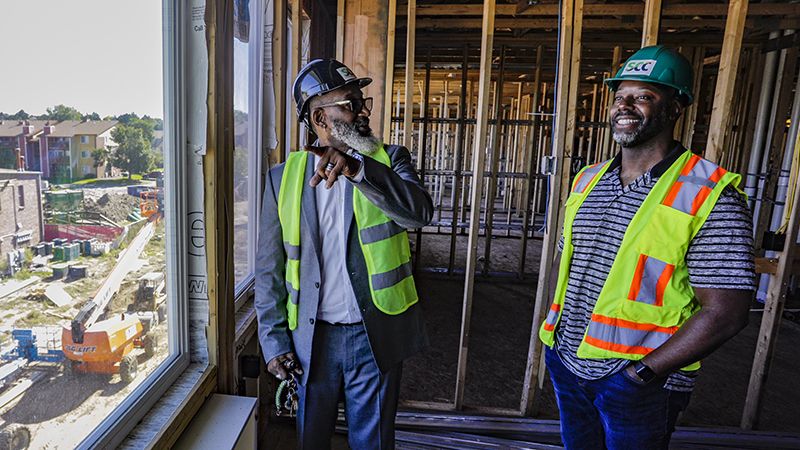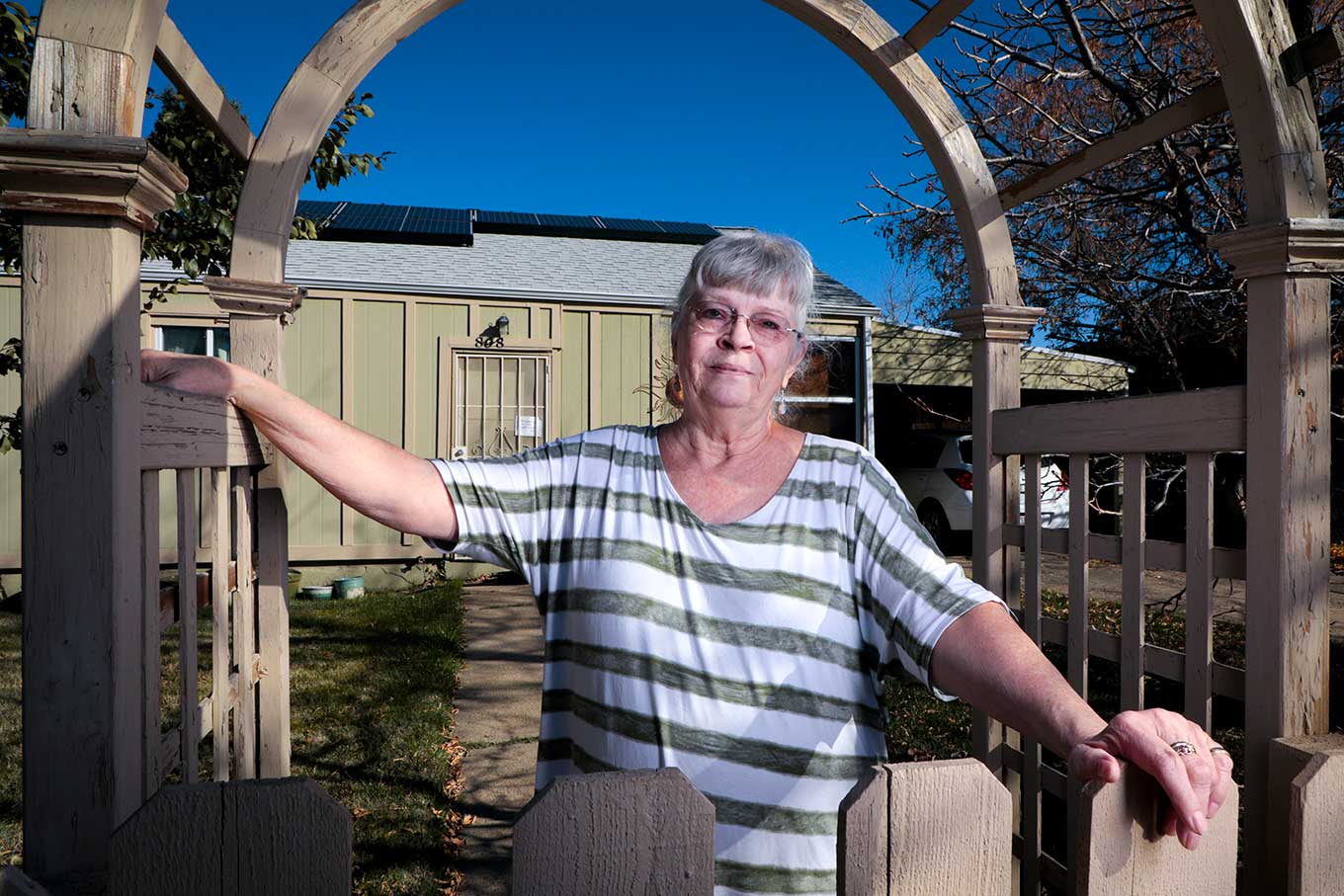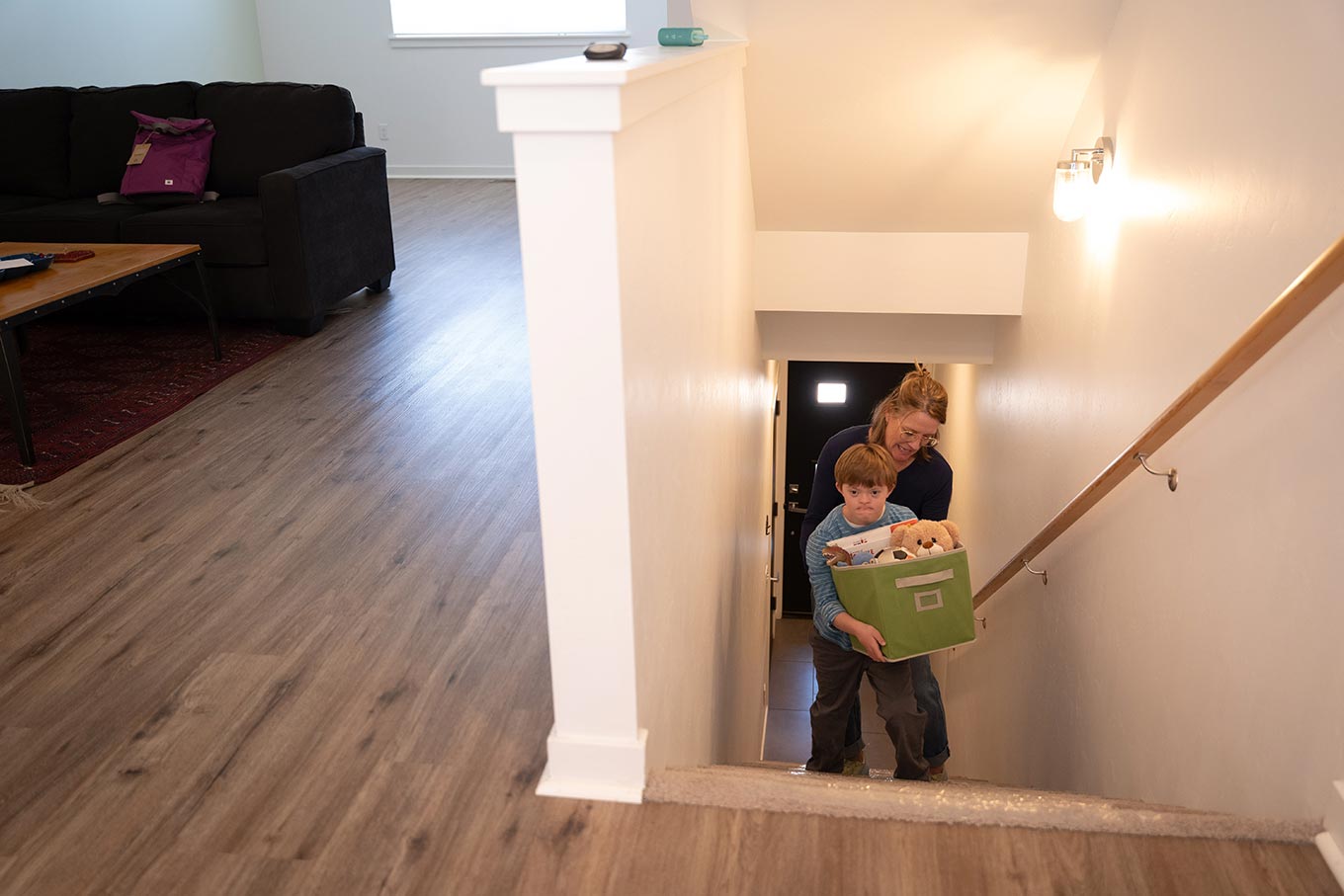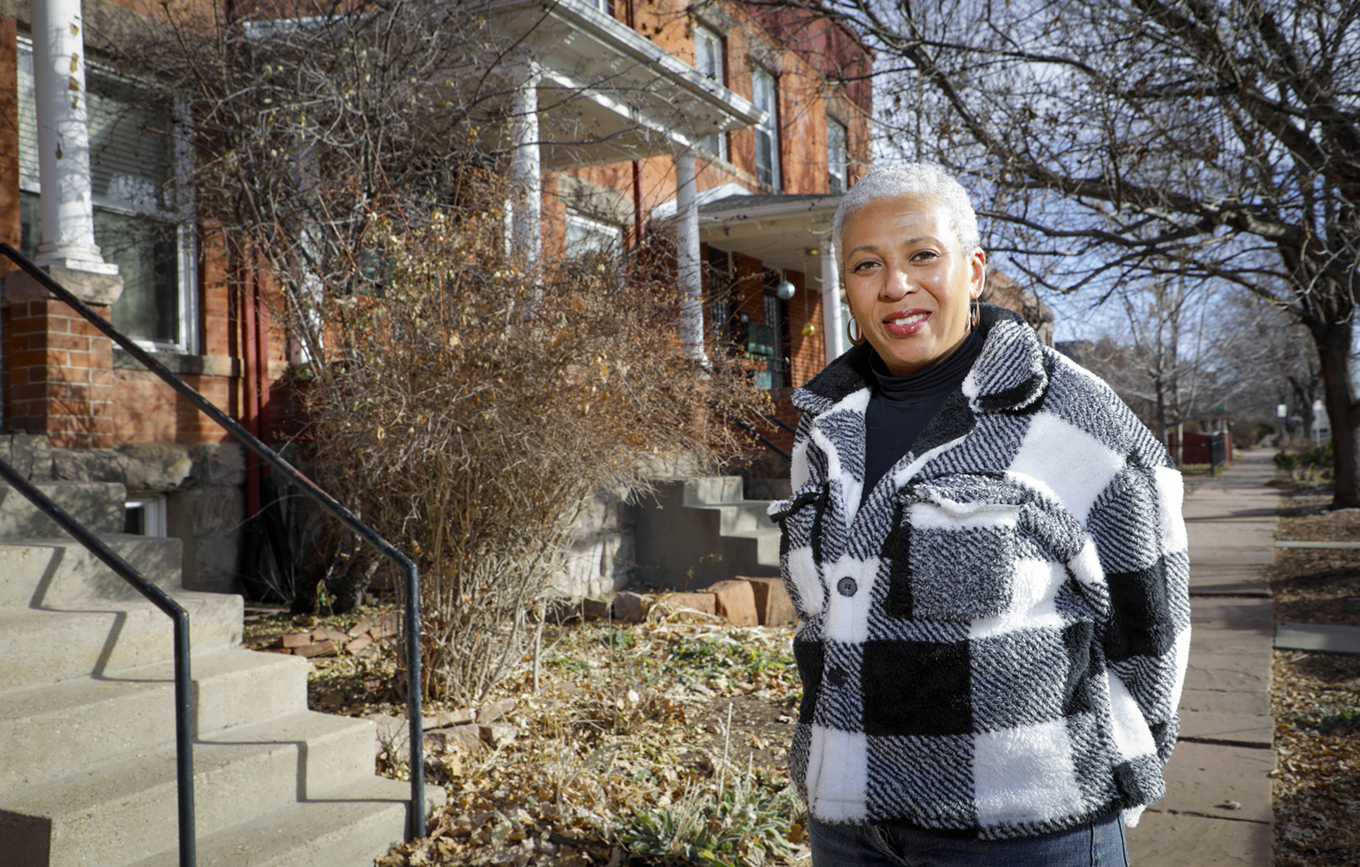As Hassan Latif and Sean Taylor slide their arms into neon safety vests and pat hard hats onto their heads, they step through the unfinished doorway of their dream housing project and begin cataloging the facts that led them to this muddy Aurora construction site:
- One hundred and fifty Coloradans exit incarceration each month, most of them with no good prospects for a place to sleep safely.
- Colorado’s recidivism rate—the portion of released felons who quickly return to prison on a new charge or parole violation—is now at nearly 50%.
- Religious groups alone own thousands of acres of open space in metro Denver that could be used for affordable housing.
When it comes to assessing post-incarceration housing challenges, Latif concludes, he and Taylor should know. After all, Latif said, “We were cellmates.”
Latif is executive director and Taylor is deputy director of the Second Chance Center for people who were formerly incarcerated. Second Chance Center has slated a January 2020 opening of this 50-unit permanent supported housing project in Aurora. Dubbed Providence at the Heights (PATH), the construction project is using $10 million in federal tax credits for a complex housing formerly incarcerated individuals, people trying to leave homelessness behind, and those with behavioral health issues needing on-site support.
The PATH building, currently on budget and on schedule, will have 40 one-bedroom apartments and 10 two-bedroom units for rent. Aurora Mental Health Center will operate on-site counseling services in mental health and addiction recovery, with group and individual meeting rooms. A bicycle repair shop will help residents out with what Second Chance Center says is clients’ most common form of transportation. A salon and barber shop is planned for job-interview grooming and as a casual gathering place. Residents will be able to check out a laptop computer or use on-site IT equipment.
All the elements are drawn from the Second Chance Center’s eight years of success helping parolees navigate new lives, and from the personal experience of people like Latif and Taylor. After 18 years in prison for armed robbery, Latif spent much of his first release time in 2006 sleeping in and working out of a car.
“When there’s an element of instability in housing, it affects everything else you are trying to do,” he said. “If you are uncertain where you are sleeping tonight, it’s hard to get up the next morning and go to a job interview, etcetera.”
Improving prisoner transitions and avoiding recidivism are crucial to current criminal-justice reform efforts, many of which stem from recognition of stark inequities in sentencing and imprisonment policies. People of color and people from lower-income communities are heavily overrepresented in American prisons; Colorado matches those trends.
As pointed out during recent efforts to “Ban the Box” on employment applications, an ACLU report noted that while African Americans made up 4% of the Colorado population as of 2017, they comprised 18% of inmates. Latinos were similarly overrepresented, making up 19% of the state population but 32% of those behind bars.
According to the same ACLU report, in 2014 Colorado had the ninth highest imprisonment rate in the nation for African Americans, and the fourth highest rate for Latinos, per 100,000 adults.
Recidivism rates, meanwhile, remain high in Colorado. The Colorado Department of Corrections’ most recent reported recidivism rate (re-arrest within a year of release) was 48.1%, well over the national average.
“Of the roughly 54,000 felonies filed in the state in 2018, fully half were against people who were already in the criminal justice system or had a prior criminal record,” according to Colorado Public Radio, a rate one prosecutor quoted in the CPR story called “lethal.”
Brian Crenshaw, 56, has worked to avoid being such a statistic for the last five years, since finishing two and a half years in prison on a felony conviction. He found Second Chance Center, based in Aurora not far from the new housing project, and they assigned him a case manager.
“They enveloped me with nothing but concern,” Crenshaw said. “Being an ex-con makes it really difficult to find appropriate housing. I had felonies on my record that would be so unattractive to most of the landlords around here.”
Crenshaw said he understands when landlords, neighbors or employers have instant negative reactions to the presence of formerly incarcerated people. “The problem is, you have to start somewhere,” he added. “Give people the chance to show they’ve changed. Second Chance allows people who have exhibited change to reenter society.”
Crenshaw plans to be around when people he “walked the yard with” in prison are outside and looking for help. Second Chance has hired him as the maintenance staffer when PATH opens to residents.
The Second Chance approach—going all in for people with a criminal record who are willing to work for a better, healthier life—has a bankable track record for investors. Those counseled by Second Chance have a recidivism rate below 10%, and below 6% in the most recent period reported to monitoring agencies, Latif said.
“These sources of funding [for PATH], they vetted us more than their normal projects,” Latif said. “They vetted every level of our staff,” many of whom were previously incarerated, he noted. “Could we be stewards of this large a resource? [PATH funders] didn’t do it out of the goodness of their hearts—they are business people.”
The majority of PATH’s construction funding comes from $10 million in low-income housing tax credits purchased by investors working with the National Equity Fund, a nonprofit connector between developers and social causes. Rules for the federal tax credit program required expanding the units’ availability to more low-income groups, so Aurora Mental Health will be the agent for screening residents who have either been incarcerated, homeless or both.
Among those ineligible for a PATH unit are people with convictions for sex crimes, arson or methamphetamine production. Those with violent-crime convictions aren’t immediately disqualified, and are evaluated on a case-by-case basis. Time elapsed since the offense is a significant factor in considering eligibility, Latif said.
Resident candidates will qualify financially if they make up to 30% of the area median income, which is about $21,000. The resident would then be asked to pay rent of about 30% of their income, with the remainder offset by state housing authority vouchers.
When Latif and Taylor tour the construction site, they see physical reminders of both opportunities and obstacles. On the second story, they look out a windowless opening to the south, straight into the yards of Tollgate Park neighbors. Designs for Providence at the Heights originally included a green rooftop for energy savings and therapeutic gardening, but planners realized edgy neighbors would feel uncomfortable with former felons gazing down from above. Some neighbors even suggested eliminating apartment windows entirely on the south walls.
Latif, whose usual speaking manner is soothing and compromising, took a different tack on that proposal.
“Our solution to that was big-ass windows,” he said with a chuckle.
Defiance was not the strategy a year ago, when the proposal for PATH faced a not-in-my-backyard backlash at an Aurora City Council hearing. PATH needed approval for a site plan on the small plot, bought from the next-door Elevation Christian Church, which supports the housing project.
Before the council hearing and vote, PATH supporters knocked on hundreds of doors in the neighborhood to explain the project and answer questions. The council meeting stretched past five hours, with a couple dozen speakers objecting to the project as a threat to “the wholesomeness” of families nearby. They expressed concerns about too few parking spaces, a building that is out of proportion to single-family homes, and the potential behavior of residents coming from a background of prison or homelessness.
The council voted 6-5 to let PATH move forward. PATH leaders said they try not to take objections to ex-inmate programs personally, and that formerly incarcerated individuals must continue to account for their past actions.
“It’s not a setback. It’s a motivator. It’s up to us to shatter those feelings,” Taylor said. “We tell people to expect that—we left behind bad footprints.”
The burgeoning nationwide movement for criminal justice reform will have to take on housing issues to make real progress, as well as family reunification, mental health care and employment equity, said University of Colorado associate sociology professor David Pyrooz, PhD, who studies criminology. With approximately 20,000 people in Colorado’s prisons, thousands are coming out each year, he noted. “If you want them to reintegrate and you don’t want to foot their bill for life sentences, there’s got to be a place they end up,” he said.
When communities don’t work on housing former inmates, recidivism never ends, Pyrooz said. He is involved in a longitudinal study of thousands of Texas inmates, and one set of questions revealed that more than a third of the formerly incarcerated individuals moved at least once within 10 months of release. Comparatively, U.S. Census data shows about 10% of the overall population moving in a given year, Pyrooz noted.
Neighbors will understandably raise questions, Pyrooz said, though he believes many halfway houses in Colorado, housing people with less support than Second Chance offers, still manage to operate with no community concerns.
“If they can demonstrate success, that could be pretty convincing” for supporting future projects, Pyrooz said. “What does their recidivism look like? What does their housing look like? Are they getting jobs? How long are they relying on it, and what does life look like afterwards?”
A key portion of the Second Chance and PATH approach to long-term success, Latif said, is to encourage clients to see themselves as part of a larger goal. Quantifiable success in reducing recidivism attracts investors, grants, support from corrections officials and, ultimately, community acceptance.
“We say to our people: The better they do, the better we are able to do,” Latif said.
The developers of PATH want to look back on the apartment building as a first, not a one-off. “This just scratches the surface. We hope our work here will be a template for people wanting to develop other housing,” Latif said.
“Our most ardent hope is that the people who opposed this project two years from now will be asking themselves, ‘Why was I even trippin’?”






